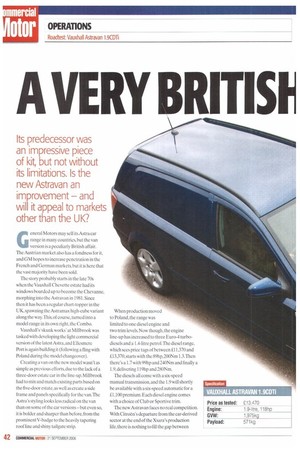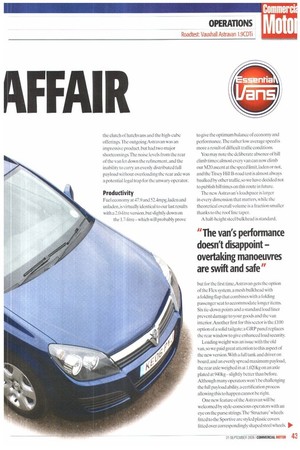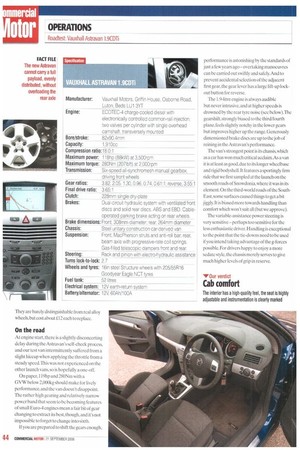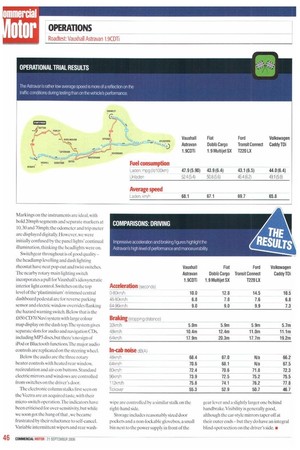A VERY 111111 1 1SE
Page 42

Page 43

Page 44

Page 45

Page 46

If you've noticed an error in this article please click here to report it so we can fix it.
RFFIt
Its predecessor was an impressive piece of kit, but not without its limitations. Is the new Astravan an
improvement — and
will it appeal to markets other than the UK?
General Motors may sell its Astra car range in many countries, but the van version is a peculiarly British affair. The Austrian market also has a fondness for it, and GM hopes to increase penetration in the French and German markets, but it is here that the vast majority have been sold.
The story probably starts in the late 70s when the Vauxhall Chevette estate had its windows boarded up to become the Chevanne, morphing into the Astravan in 1981.Since then it has been a regular chart-topper in the UK, spawning the Astramax high-cube variant along the way. This. of course, turned into a model range in its own right, the Combo.
Vauxhall's 'skunk works' at Millbrook was tasked with developing the light commercial version of the latest Astra, and Ellesmere Port is again building it (following a fling with Poland during the model changeover).
Creating a van on the new model wasn't as simple as previous efforts, due to the lack of a three-door estate car in the line-up.Millbrook had to mix and match existing parts based on the five-door estate, as well as create a side frame and panels specifically for the van.The Astra's styling looks less radical on the van than on some of the car versions— but even so, it is bolder and sharper than before,from the prominent V-badge to the heavily tapering roof line and shiny tailgate strip. When production moved to Poland, the range was limited to one diesel engine and two trim levels. Now though.the engine line-up has increased to three Euro-4 turbodiesels and a 1.4-litre petrol. The diesel range, which sees price tags of between £11,370 and £13,370, starts with the 89hp, 200Nm 1.3.Then there's a 1.7 with 99hp and 240Nm and finally a 1.9, delivering 119hp and 280Nm.
The diesels all come with a six-speed manual transmission, and the 1.9 will shortly be available with a six-speed automatic for a £1,100 premium. Each diesel engine comes with a choice of Club or Sportive trim.
The new Astravan faces no real competition. With Citron's departure from the car-derived sector at the end of the Xsara's production life, there is nothing to fill the gap between the clutch of hatchvans and the high-cube offerings. The outgoing Astravan was an impressive product. but had two major shortcomings.The noise levels from the rear of the van let down the refinement, and the inability to carry an evenly distributed full payload without overloading the rear axle was a potential legal trap for the unwary operator.
Productivity Fuel economy at 47.9 and 52.4mpg, laden and unladen, is virtually identical to our last results with a 2.0-litre version, but slightly down on the 1.7-litre — which will probably prove to give the optimum balance of economy and performance. The rather low average speed is more a result of difficult traffic conditions.
You may note the deliberate absence of hill climb times; almost every van can now climb our M20 ascent at the speed limit, laden or not, and theTitsey Hill B-road test is almost always baulked by other traffic,so we have decided not to publish hill times on this route in future.
The new Astravan's loadspace is larger in every dimension that matters, while the theoretical overall volume is a fraction smaller thanks to the roof line taper.
A half-height steel bulkhead is standard, but for the first time,Astravan gets the option of the Flex system, a mesh bulkhead with a folding flap that combines with a folding passenger seat to accommodate longer items. Six tie-down points and a standard load liner prevent damage to your goods and the van interior. Another first for this sector is the £100 option of a solid tailgate:a GRP panel replaces the rear window to give enhanced load security.
Loading weight was an issue with the old van, so we paid great attention to this aspect of the new version.With a full tank and driver on board, and an evenly spread maximum payload, the rear axle weighed in at 1.020kg on an axle plated at 940kg —slightly better than before. Although many operators won't be challenging the full payload ability.a certification process allowing this to happen cannot be right.
One new feature of the Astravan will be welcomed by style-conscious operators with an eye on the purse strings. The 'Structure' wheels fitted to the Sportive are styled plastic covers fitted over correspondingly shaped steel wheels. They are barely distinguishable from real alloy wheels, but cost about £12 each to replace.
On the road At engine start, there is a slightly disconcerting delay during the Astravan's self-check process, and our test van intermittently suffered from a slight hiccup when applying the throttle from a steady speed.This was not experienced on the other launch vans, so is hopefully a one-off.
On paper,119hp and 280Nm with a GVW below 2,000kg should make for lively performance, and the van doesn't disappoint. The rather high gearing and relatively narrow power band that seem to be becoming features of small Euro-4 engines mean a fair bit of gear changing to extract its best, though, and it's not impossible to forget to change into sixth.
If you are prepared to shift the gears enough, performance is astonishing by the standards of just a few years ago— overtaking manoeuvres can be carried out swiftly and safely.And to prevent accidental selection of the adjacent first gear, the gear lever has a large lift-up lockout button for reverse.
The 1.9-litre engine is always audible but never intrusive, and at higher speeds is drowned by the rear tyre noise (see below).The gearshift. strongly biased to the third/fourth plane.feels slightly notchy in the lower gears but improves higher up the range. Generously dimensioned brake discs are up to the job of reining in the Astravan's performance.
The van's strongest point is its chassis, which as a car has won much critical acclaim.As a van it is at least as good, due to its longer wheelbase and rigid bodyshell. It features a sportingly firm ride that we first sampled at the launch on the smooth roads of Snowdonia, where it was in its element. On the third-world roads of the SouthEast, some surfaces caused things to get a bit jiggly. It is biased more towards handling than comfort which won't suit all (but we approve).
The variable-assistance power steering is very sensitive — perhaps too sensitive for the less enthusiastic driver. Handling is exceptional to the point that the tie-downs need to be used if you intend taking advantage of the g-forces possible. For drivers happy to enjoy a more sedate style, the chassis merely serves to give much higher levels of grip in reserve.
Despite the foam-backed plastic load-liner, noise levels are only slightly improved the roar of the low-profile tyres is still the most intrusive feature of the driving experience. It varies according to surface, but is worse on wet roads We will wait until trying a version with less sporty tyres on familiar roads before making a final judgement, but it seems that this latest Astravan hasn't attained the standard set by the last Escort van, its last true competitor.
Cab comfort
Like the chassis, the interior is straight out of the Astra car, and has a high-quality feel that looks capable orgivingVW a run for its money. The Sportive model tested has an impressive level of trim and toys. Its cockpit includes machined aluminium-effect strips on the dash and doors, and deeply sculpted cloth sports seats Subtle chrome trim on the handbrake, gear knob and door handles adds class.The seats and matching door trim panels are black with white flecks on central panels, with heightadjustable seat-belts and soft head restraints.
A steering column adjustable for angle combines with a range of seat adjustment and well located pedals with a left footrest to ensure a comfortable driving position for all shapes.
Instrumentation consists of a panel with just rev counter, speedometer and fuel gauge, everything else being monitored electronically. Markings on the instruments are ideal, with hold 20mph segments and separate markers at 10,30 and 70mph; the odometer and trip meter are displayed digitally. However, we were initially confused by the panel lights' continual illumination, thinking the headlights were on.
Switchgear throughout is of good quality the headlamp levelling and dash lighting rheostat have neat pop-out and twist switches. The nearby rotary main lighting switch incorporates a pull forVauxhall's idiosyncratic interior light control. Switches on the top level of the 'plastiminium.-trimmed central dashboard pedestal are for reverse parking sensor and electric window overrides flanking the hazard warning switch. Below that is the £850 CD70 Navi system with large colour map display on the dash top.The system gives separate slots for audio and navigation CDs, including MP3 discs, but there's no sign of iPod or Bluetooth functions.The major audio controls are replicated on the steering wheel.
Below the audio are the three rotary heater controls with heated rear window, recirculation and air-con buttons. Standard electric mirrors and windows are controlled from switches on the driver's door.
The electronic column stalks first seen on the Vectra are an acquired taste, with their micro-switch operation.The indicators have been criticised for over-sensitivity, but while we soon got the hang of that ,we became frustrated by their reluctance to self-cancel. Variable intermittent wipers and rear wash wipe are controlled by a similar stalk on the right-hand side.
Storage includes reasonably sized door pockets and a non-lockable glove box, a small bin next to the power supply in front of the gear lever and a slightly larger one behind handbrake. Visibility is generally good, although the car-style mirrors taper off at their outer endsbut they do have an integral blind-spot section on the driver's side. si




























































































































































































